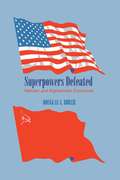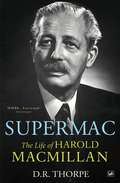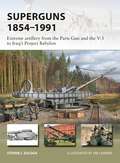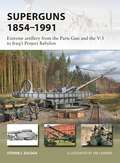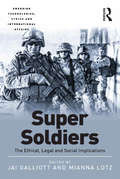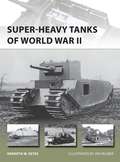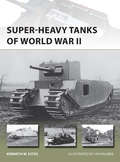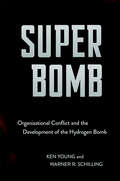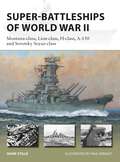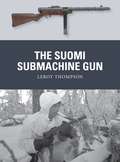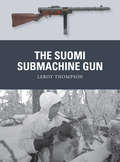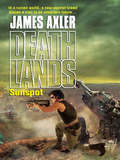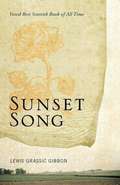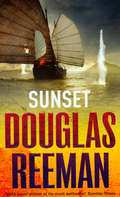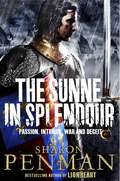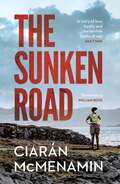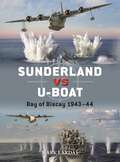- Table View
- List View
Superpowers Defeated: Vietnam and Afghanistan Compared
by Douglas A. BorerDuring the Cold War, military conflicts in Vietnam and Afghanistan validated the importanct of war in global power dynamics. But military intervention proved not to be politically sustainable for the USA and the USSR. This study investigates the parallels and differences in the two conflicts.
Supermarine Spitfire (UEB uncontracted)
by RnibThis page shows two images of an aircraft. At the top of the page seen from the side and in the bottom and middle of the page a plan view seen from above. There is a locator dot shown, which will be at the top left of the page when the image is the correct way up. Both views have the front on the left and the tail on the right of the page. The aircraft is shown in a flying position so the wheels are retracted and not shown. The aircraft in the top of the page has the propeller on the left with one blade pointing up and one pointing down. The nose cone is pale grey. Right from this is a rectangle which comprises six exhaust outlets. Down and right from the exhaust is the tip of the wing pointing towards you. The front edge on the left has a cannon sticking out. Up from the wing in the middle top of the fuselage is the cockpit cover shown as two windows. The centre of the fuselage has letters identifying which individual aircraft it is. There is also red and blue roundel indicating the plane belongs to the RAF. On the top edge of the fuselage there is an aerial sticking up. Right of this the fuselage continues to the vertical tail fin on the right. At base of the fin is the end of one of the tail wings. Right of this is a vertical flap. This is one of the ailerons used to manoeuvre the aircraft when it is flying. The tail has a red rectangle and a blue rectangle separated by a white line indicating the plane belongs to the RAF. In the plan view image in the bottom and middle of the page the fuselage goes from left to right in the centre of the image. The main wings go up and down the page from the fuselage. In the left of the page the propeller has one blade pointing up and one pointing down. The tip of the nose cone is pale grey. To the right of the propeller six exhaust outlets can be found on the top and bottom edge of the fuselage. Right of this are the wings. Each wing has two cannons mounted on the front edge. In the centre of each wing there is a red and blue roundel indicating the plane belongs to the RAF. On the right of each wing tip is a flap. These are two of the ailerons used to manoeuvre the aircraft when it is flying. In the centre of the fuselage between the wings is the cockpit shown as two windows. The fuselage continues to the right ending in the tailplane. On the right of each tail wing is a flap. These are two more of the ailerons used to manoeuvre the aircraft when it is flying.
Supermarine Spitfire (UEB contracted)
by RnibThis page shows two images of an aircraft. At the top of the page seen from the side and in the bottom and middle of the page a plan view seen from above. There is a locator dot shown, which will be at the top left of the page when the image is the correct way up. Both views have the front on the left and the tail on the right of the page. The aircraft is shown in a flying position so the wheels are retracted and not shown. The aircraft in the top of the page has the propeller on the left with one blade pointing up and one pointing down. The nose cone is pale grey. Right from this is a rectangle which comprises six exhaust outlets. Down and right from the exhaust is the tip of the wing pointing towards you. The front edge on the left has a cannon sticking out. Up from the wing in the middle top of the fuselage is the cockpit cover shown as two windows. The centre of the fuselage has letters identifying which individual aircraft it is. There is also red and blue roundel indicating the plane belongs to the RAF. On the top edge of the fuselage there is an aerial sticking up. Right of this the fuselage continues to the vertical tail fin on the right. At base of the fin is the end of one of the tail wings. Right of this is a vertical flap. This is one of the ailerons used to manoeuvre the aircraft when it is flying. The tail has a red rectangle and a blue rectangle separated by a white line indicating the plane belongs to the RAF. In the plan view image in the bottom and middle of the page the fuselage goes from left to right in the centre of the image. The main wings go up and down the page from the fuselage. In the left of the page the propeller has one blade pointing up and one pointing down. The tip of the nose cone is pale grey. To the right of the propeller six exhaust outlets can be found on the top and bottom edge of the fuselage. Right of this are the wings. Each wing has two cannons mounted on the front edge. In the centre of each wing there is a red and blue roundel indicating the plane belongs to the RAF. On the right of each wing tip is a flap. These are two of the ailerons used to manoeuvre the aircraft when it is flying. In the centre of the fuselage between the wings is the cockpit shown as two windows. The fuselage continues to the right ending in the tailplane. On the right of each tail wing is a flap. These are two more of the ailerons used to manoeuvre the aircraft when it is flying.
Supermarine Spitfire (large print)
by RnibThis page shows two images of an aircraft. At the top of the page seen from the side and in the bottom and middle of the page a plan view seen from above. There is a locator dot shown, which will be at the top left of the page when the image is the correct way up. Both views have the front on the left and the tail on the right of the page. The aircraft is shown in a flying position so the wheels are retracted and not shown. The aircraft in the top of the page has the propeller on the left with one blade pointing up and one pointing down. The nose cone is pale grey. Right from this is a rectangle which comprises six exhaust outlets. Down and right from the exhaust is the tip of the wing pointing towards you. The front edge on the left has a cannon sticking out. Up from the wing in the middle top of the fuselage is the cockpit cover shown as two windows. The centre of the fuselage has letters identifying which individual aircraft it is. There is also red and blue roundel indicating the plane belongs to the RAF. On the top edge of the fuselage there is an aerial sticking up. Right of this the fuselage continues to the vertical tail fin on the right. At base of the fin is the end of one of the tail wings. Right of this is a vertical flap. This is one of the ailerons used to manoeuvre the aircraft when it is flying. The tail has a red rectangle and a blue rectangle separated by a white line indicating the plane belongs to the RAF. In the plan view image in the bottom and middle of the page the fuselage goes from left to right in the centre of the image. The main wings go up and down the page from the fuselage. In the left of the page the propeller has one blade pointing up and one pointing down. The tip of the nose cone is pale grey. To the right of the propeller six exhaust outlets can be found on the top and bottom edge of the fuselage. Right of this are the wings. Each wing has two cannons mounted on the front edge. In the centre of each wing there is a red and blue roundel indicating the plane belongs to the RAF. On the right of each wing tip is a flap. These are two of the ailerons used to manoeuvre the aircraft when it is flying. In the centre of the fuselage between the wings is the cockpit shown as two windows. The fuselage continues to the right ending in the tailplane. On the right of each tail wing is a flap. These are two more of the ailerons used to manoeuvre the aircraft when it is flying.
Supermac: The Life of Harold Macmillan
by Dr D R ThorpeGreat-grandson of a crofter and son-in-law of a Duke, Harold Macmillan (1894-1986) was both complex as a person and influential as a politican. Marked by terrible experiences in the trenches in the First World War and by his work as an MP during the Depression, he was a Tory rebel - an outspoken backbencher, opposing the economic policies of the 1930s and the appeasement policies of his own government.Churchill gave him responsibility during the Second World War with executive command as 'Viceroy of the Mediterranean'. After the War, in opposition, Macmillan was one of the principal reformers of the Conservatives, and after 1951, back in government, served in several important posts before becoming Prime Minister after the Suez Crisis.Supermac examines key events including the controversy over the Cossacks repatriation, the Suez Crisis, You've Never Had It So Good, the Winds of Change, the Cuban Missile Crisis and the Profumo Scandal. The culmination of thirty-five years of research into this period by one of our most respected historians, this book gives an unforgettable portrait of a turbulent age.Shortlisted for the Orwell Prize.
Superguns 1854–1991: Extreme artillery from the Paris Gun and the V-3 to Iraq's Project Babylon (New Vanguard)
by Steven J. ZalogaOver the last 150 years, gun designers have sought to transform warfare with artillery of superlative range and power, from William Armstrong's 19th-century “monster guns” to the latest research into hypersonic electro-magnetic railguns.Taking a case study approach, Superguns explains the technology and role of the finest monster weapons of each era. It looks at the 1918 “Wilhelm Gun,” designed to shell Paris from behind the German trenches; the World War II “V-3” gun built to bombard London across the Channel; the Cold War atomic cannons of the US and Soviet Union; and the story of Dr Gerald Bull's HARP program and the Iraqi “Supergun” he designed for Saddam Hussein. Illustrated throughout, this is an authoritative history of the greatest and most ambitious artillery pieces of all time.
Superguns 1854–1991: Extreme artillery from the Paris Gun and the V-3 to Iraq's Project Babylon (New Vanguard #265)
by Steven J. Zaloga Jim LaurierOver the last 150 years, gun designers have sought to transform warfare with artillery of superlative range and power, from William Armstrong's 19th-century “monster guns” to the latest research into hypersonic electro-magnetic railguns.Taking a case study approach, Superguns explains the technology and role of the finest monster weapons of each era. It looks at the 1918 “Wilhelm Gun,” designed to shell Paris from behind the German trenches; the World War II “V-3” gun built to bombard London across the Channel; the Cold War atomic cannons of the US and Soviet Union; and the story of Dr Gerald Bull's HARP program and the Iraqi “Supergun” he designed for Saddam Hussein. Illustrated throughout, this is an authoritative history of the greatest and most ambitious artillery pieces of all time.
Super Soldiers: The Ethical, Legal and Social Implications (Emerging Technologies, Ethics and International Affairs)
by Jai Galliott Mianna LotzThe Spartan City State produced what is probably one of the most iconic and ruthless military forces in recorded history. They believed that military training and education began at birth. Post-World War II saw a shift to army tanks, fighter jets and missiles that would go on to fight the next huge battle in Northern Europe. Today, with the advent of unmanned systems, our hopes are attached to the idea that we can fight our battles with soldiers pressing buttons in distant command centres. However, soldiers must now be highly trained, super strong and have the intelligence and mental capacity to handle the highly complex and dynamic military operating environment. It is only now as we progress into the twenty-first century that we are getting closer to realising the Spartan ideal and creating a soldier that can endure more than ever before. This book provides the first comprehensive and unifying analysis of the moral, legal and social questions concerning military human enhancement, with a view toward developing guidance and policy that may influence real-world decision making.
Super Soldiers: The Ethical, Legal and Social Implications (Emerging Technologies, Ethics and International Affairs)
by Jai Galliott Mianna LotzThe Spartan City State produced what is probably one of the most iconic and ruthless military forces in recorded history. They believed that military training and education began at birth. Post-World War II saw a shift to army tanks, fighter jets and missiles that would go on to fight the next huge battle in Northern Europe. Today, with the advent of unmanned systems, our hopes are attached to the idea that we can fight our battles with soldiers pressing buttons in distant command centres. However, soldiers must now be highly trained, super strong and have the intelligence and mental capacity to handle the highly complex and dynamic military operating environment. It is only now as we progress into the twenty-first century that we are getting closer to realising the Spartan ideal and creating a soldier that can endure more than ever before. This book provides the first comprehensive and unifying analysis of the moral, legal and social questions concerning military human enhancement, with a view toward developing guidance and policy that may influence real-world decision making.
Super-heavy Tanks of World War II (New Vanguard)
by Ian Palmer Kenneth W EstesThe super-heavy tanks of World War II are heirs to the siege machine tradition – a means of breaking the deadlock of ground combat. As a class of fighting vehicle, they began with the World War I concept of the search for a 'breakthrough' tank, designed to cross enemy lines. It is not surprising that the breakthrough tank projects of the period prior to World War II took place in the armies that suffered the most casualties of the Great War (Russia, France, Germany). All of the principal Axis and Allied nations eventually initiated super-heavy development projects, with increasingly heavy armor and armament. Much as the casualties of World War I prompted the original breakthrough tank developments, as Germany found itself on the defensive, with diminishing operational prospects and an increasingly desperate leadership, so too did its focus turn to the super-heavy tanks that could turn the tide back in their favor.
Super-heavy Tanks of World War II (New Vanguard #216)
by Ian Palmer Kenneth W EstesThe super-heavy tanks of World War II are heirs to the siege machine tradition – a means of breaking the deadlock of ground combat. As a class of fighting vehicle, they began with the World War I concept of the search for a 'breakthrough' tank, designed to cross enemy lines. It is not surprising that the breakthrough tank projects of the period prior to World War II took place in the armies that suffered the most casualties of the Great War (Russia, France, Germany). All of the principal Axis and Allied nations eventually initiated super-heavy development projects, with increasingly heavy armor and armament. Much as the casualties of World War I prompted the original breakthrough tank developments, as Germany found itself on the defensive, with diminishing operational prospects and an increasingly desperate leadership, so too did its focus turn to the super-heavy tanks that could turn the tide back in their favor.
Super Bomb: Organizational Conflict and the Development of the Hydrogen Bomb (Cornell Studies in Security Affairs)
by Ken Young Warner R. SchillingSuper Bomb unveils the story of the events leading up to President Harry S. Truman's 1950 decision to develop a "super," or hydrogen, bomb. That fateful decision and its immediate consequences are detailed in a diverse and complete account built on newly released archives and previously hidden contemporaneous interviews with more than sixty political, military, and scientific figures who were involved in the decision. Ken Young and Warner R. Schilling present the expectations, hopes, and fears of the key individuals who lobbied for and against developing the H-bomb. They portray the conflicts that arose over the H-bomb as rooted in the distinct interests of the Atomic Energy Commission, the Los Alamos laboratory, the Pentagon and State Department, the Congress, and the White House. But as they clearly show, once Truman made his decision in 1950, resistance to the H-bomb opportunistically shifted to new debates about the development of tactical nuclear weapons, continental air defense, and other aspects of nuclear weapons policy. What Super Bomb reveals is that in many ways the H-bomb struggle was a proxy battle over the morality and effectiveness of strategic bombardment and the role and doctrine of the US Strategic Air Command.
Super-Battleships of World War II: Montana-class, Lion-class, H-class, A-150 and Sovetsky Soyuz-class (New Vanguard)
by Mark StilleA study of the design, development and eventual fates of the uncompleted super-battleships intended to be built before and during World War II. At the start of World War II the battleship was still king, and all the major powers were designing even mightier battleships to surpass their most modern and powerful classes. But when World War II broke out, aircraft carriers would dominate naval warfare, and none of these monster warships were completed.In this book, naval expert Mark Stille uncovers these lost battleships as they are reconstructed with superb new full-colour artwork. The US Navy wanted five Montana-class ships, based on the Iowas but with a heavier main battery and improved protection, and the Royal Navy began work on three 16in-gun Lion-class fast battleships. The German Navy developed its H-class designs: initially an improved Bismack-class, they became more fantastical, culminating in the 141,500-ton, 20in-gun H-44. The Japanese A-150 was based on the Yamato-class but with 20.1in guns, while the 15 ships planned for the USSR's Sovetsky Soyuz-class would have rivalled the Montanas in size. Explaining the design, intended roles and fate of these ships, this is the story of the last battleship designs in history.
Super-Battleships of World War II: Montana-class, Lion-class, H-class, A-150 and Sovetsky Soyuz-class (New Vanguard)
by Mark StilleA study of the design, development and eventual fates of the uncompleted super-battleships intended to be built before and during World War II. At the start of World War II the battleship was still king, and all the major powers were designing even mightier battleships to surpass their most modern and powerful classes. But when World War II broke out, aircraft carriers would dominate naval warfare, and none of these monster warships were completed.In this book, naval expert Mark Stille uncovers these lost battleships as they are reconstructed with superb new full-colour artwork. The US Navy wanted five Montana-class ships, based on the Iowas but with a heavier main battery and improved protection, and the Royal Navy began work on three 16in-gun Lion-class fast battleships. The German Navy developed its H-class designs: initially an improved Bismack-class, they became more fantastical, culminating in the 141,500-ton, 20in-gun H-44. The Japanese A-150 was based on the Yamato-class but with 20.1in guns, while the 15 ships planned for the USSR's Sovetsky Soyuz-class would have rivalled the Montanas in size. Explaining the design, intended roles and fate of these ships, this is the story of the last battleship designs in history.
The Suomi Submachine Gun (Weapon)
by Adam Hook Leroy Thompson Alan GillilandEntering service in 1931, the 9x19mm Suomi KP/-31 submachine gun saw extensive combat with Finnish troops during their fight against Soviet forces in 1939–44. It was also manufactured under licence in Switzerland, Denmark and Sweden, and remained in Finnish service until the 1980s, an indication of its durability.Rugged and accurate, the Suomi was a favourite with Finnish ski troops who would strike from ambush, cutting down Soviet troops, then skiing away into the woods. Initially used by the Finns as a light machine gun at infantry squad level, it eventually became a dedicated submachine gun, and since it had been designed to be more accurate than the typical SMG, it was often even used as a sniping weapon, or to supplement longer-ranged rifles such as the Mosin-Nagant. Featuring first-hand accounts and specially commissioned colour artwork, this is the story of one of World War II's most distinctive and respected infantry weapons.
The Suomi Submachine Gun (Weapon #54)
by Adam Hook Leroy Thompson Alan GillilandEntering service in 1931, the 9x19mm Suomi KP/-31 submachine gun saw extensive combat with Finnish troops during their fight against Soviet forces in 1939–44. It was also manufactured under licence in Switzerland, Denmark and Sweden, and remained in Finnish service until the 1980s, an indication of its durability.Rugged and accurate, the Suomi was a favourite with Finnish ski troops who would strike from ambush, cutting down Soviet troops, then skiing away into the woods. Initially used by the Finns as a light machine gun at infantry squad level, it eventually became a dedicated submachine gun, and since it had been designed to be more accurate than the typical SMG, it was often even used as a sniping weapon, or to supplement longer-ranged rifles such as the Mosin-Nagant. Featuring first-hand accounts and specially commissioned colour artwork, this is the story of one of World War II's most distinctive and respected infantry weapons.
Sunspot
by James AxlerIn the wake of a nuclear Armageddon, the hellscape of Deathlands conspires to torment strong and weak alike, festering most deeply in those who still possess the deepest core of human decency. Now the past lies in the ashes, while the mysteries of the future unfold in the hands of those willing to live each new day in search of hope for tomorrow.
The Sunshine of your Smile: Two friends come to the rescue in this moving Liverpool saga (Molly and Nellie series, Book 6)
by Joan JonkerMolly and Nellie save the day once again... in their own entertaining and hilarious way. Joan Jonker brings us another instalment of her hugely popular Molly and Nellie series in The Sunshine of Your Smile, where the two friends get up to more mischief in their beloved Liverpool. Perfect for fans of Dilly Court and Cathy Sharp.'Joan Jonker does what she does best, drawing on her own upbringing during the 1930s to colour her characters. She writes about warm, witty women who inhabit a familiar world much loved by her legions of fans' - Liverpool EchoMolly Bennett and Nellie McDonough have been best mates for over twenty years, with never a cross word between them. When times were bad and money scarce, they kept their families together with love and laughter. And they were always there to help anyone in trouble. So when they hear about a mother who hasn't seen her son for years, the two friends know they have a job to do... What readers are saying about The Sunshine of Your Smile: 'I have read this book at least 5 times, and I still laugh and it can draw the tears from my eyes. I think we all wish we had a Molly and a Nellie living next to us''Again a fantastic story from Joan, Molly and Nellie never fail to entertain us with their escapades. There is everything we have come to expect from the two best mates, an abundance of tears, from joy to romance to heartache but most of all tears of laughter. All in all a fantastic read'
Sunset Song (PDF)
by Lewis Grassic GibbonSunset Song is the first and most celebrated of Grassic Gibbon's great trilogy, A Scot's Quair. It provides a powerful description of the first two decades of the century through the evocation of change and the lyrical intensity of its prose. It is hard to find any other Scottish novel of the last century which has received wider acclaim and better epitomises the feelings of a nation.
Sunset
by Douglas ReemanEnthralling navel fiction by Douglas Reeman; he has also written over twenty bestselling novels featuring Richard Bolitho, under the pseudonym Alexander Kent.1941To the residents and defence forces of the Crown Colony of Hong Kong, th war in Europe remains remote. Even the massive build-up of Japanese forces on the Chinese border cannot dent their carefree optimism.Yet one man suspects the truth. Lieutenant-Commander Esmond Brooke, captain of HMS Serpent and a veteran of the cruel Atlantic, sees all too clearly the folly and incometence of Hong Kong's colonial administration. To Brooke, attack by Japan seemsinevitable.But, in war, there will always be some who attempt the impossible, even in the face of death. This is the story of one ship and her company who refuse to accept the anguish of defeat and surrender to a merciless enemy...
The Sunne in Splendour
by Sharon PenmanThis special thirtieth anniversary edition of the bestselling The Sunne in Splendour, features an author's note from Sharon Penman. Richard, last-born son of the Duke of York, was seven months short of his nineteenth birthday when he bloodied himself at the battles of Barnet and Tewkesbury, earning his legendary reputation as a battle commander in the Wars of the Roses, and ending the Lancastrian line of succession. But Richard was far more than a warrior schooled in combat. He was also a devoted brother, an ardent suitor, a patron of the arts, an indulgent father, a generous friend. Above all, he was a man of fierce loyalties, great courage and firm principles, who was ill at ease among the intrigues of Edward's court. The very codes Richard lived by ultimately betrayed him. But he was betrayed by history too. Leaving no heir, his reputation was at the mercy of his successor, and Henry Tudor had too much at stake to risk mercy. Thus was born the myth of King Richard III, the man who would stop at nothing to gain the throne. Filled with the sights and sounds of battle, the customs and love of daily life, the rigours and dangers of Court politics and the touching concerns of very real men and women, The Sunne in Splendour is a richly coloured tapestry of medieval England.
Sunlight Hours: Three women united by the secrets of a river . . .
by Caroline CaugantThirty-something Parisian artist Billie is working towards her next exhibition when she receives the news that her mother, with whom she has had no contact for years, has drowned in the river near her nursing home. In an attempt to understand the circumstances of her death, she returns to V, the village where she grew up in the parched, sun-drenched hills above the Mediterranean. When she arrives there, Billie finds herself reliving memories of another river drowning, 20 years earlier, memories she had tried to obliterate. What happened to Billie's dear friend Lila back then, at the age of 16, and why is Billie stalked by guilt? Sunlight Hours paints a picture of three generations of women, united by the secrets of a river.
The Sunken Road
by Ciaran McMenamin'Tremendous' William BoydA powerful and gripping novel about love, loyalty and obsession set during World War One and the Irish War of Independence. Francie, Archie and Annie grew up playing together in the hills and rivers of Fermanagh. But in 1914, the boys are seduced by the drama of the war in Europe and leave the village to join up. Before they leave, Francie swears to Annie that he'll keep her little brother safe. Six years later Francie is hiding out in the barn of Annie's house. He hasn't seen her since that day. He's on the run, a wanted man in the war for independence that is still igniting along the border. And the British officer who is obsessively pursuing him is his old commander from the Western Front. To reach safety Francie will need Annie's help getting over the border, and that means he'll have to confront the truth about why Archie never came back. Powerfully gripping, Ciaran McMenamin's accomplished novel explores loyalty, love, heroism and the heartbreaking cost of violence.
Sunderland vs U-boat: Bay of Biscay 1943–44 (Duel #130)
by Mark LardasAn illustrated examination of the role played by the Sunderland as an antisubmarine aircraft during the Battle of the Atlantic, focusing on the key battles of the Biscay campaign in 1943–44.The Sunderland is an iconic British aircraft of World War II, and the only RAF Coastal Command type to perform frontline service throughout the conflict. Its prime target – the German U-boat – was a deadly adversary to Allied warships and other oceangoing vessels, but proved vulnerable to detection and air attacks from the radar-equipped Sunderland. This book examines the respective advantages and drawbacks of these two maritime predators by providing a vivid analysis of their historic engagement during the Biscay campaign in 1943–44.Drawing upon first-hand accounts of this famous duel, Mark Lardas tells the story of how highly skilled Sunderland crews took the fight to an often elusive enemy and helped RAF Coastal Command defeat the U-boat threat. Maps, tactical diagrams, photographs and specially commissioned artwork bring the action to life as the Sunderland's losses – and eventual victory – in the Bay of Biscay play out in fascinating, insightful detail.
Sunderland vs U-boat: Bay of Biscay 1943–44 (Duel #130)
by Mark LardasAn illustrated examination of the role played by the Sunderland as an antisubmarine aircraft during the Battle of the Atlantic, focusing on the key battles of the Biscay campaign in 1943–44.The Sunderland is an iconic British aircraft of World War II, and the only RAF Coastal Command type to perform frontline service throughout the conflict. Its prime target – the German U-boat – was a deadly adversary to Allied warships and other oceangoing vessels, but proved vulnerable to detection and air attacks from the radar-equipped Sunderland. This book examines the respective advantages and drawbacks of these two maritime predators by providing a vivid analysis of their historic engagement during the Biscay campaign in 1943–44.Drawing upon first-hand accounts of this famous duel, Mark Lardas tells the story of how highly skilled Sunderland crews took the fight to an often elusive enemy and helped RAF Coastal Command defeat the U-boat threat. Maps, tactical diagrams, photographs and specially commissioned artwork bring the action to life as the Sunderland's losses – and eventual victory – in the Bay of Biscay play out in fascinating, insightful detail.
